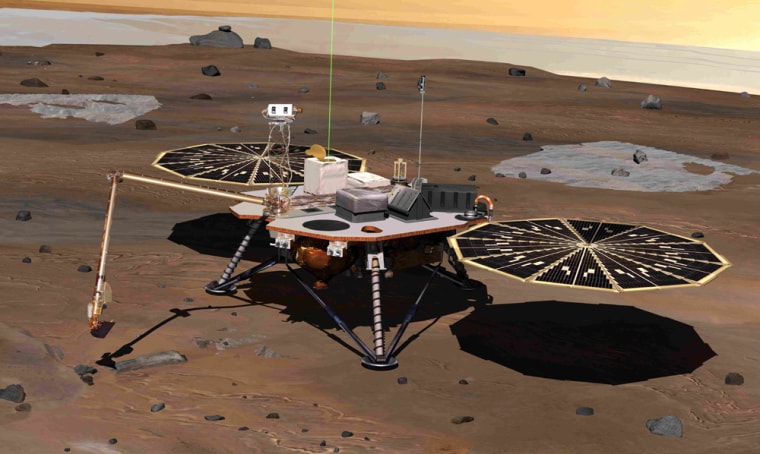NASA's Phoenix Mars Lander lived up to its name — rising from the ashes of an earlier failed Mars landing attempt to go on to a successful mission. But now the probe has a chance to rise from the dead itself.
Phoenix touched down in Mars' northern plains in May 2008 and lasted for five months, exceeding its originally planned three-month mission. The robot quite literally dug up a number of scientific findings — including, perhaps, liquid water.
Eventually Phoenix succumbed to the bitterly cold winter on Mars. But now scientists are warming up to the prospect of re-establishing contact with Phoenix.
"We start listening in January for signals from our lander," said Peter Smith, Phoenix principal investigator at the Lunar and Planetary Lab at the University of Arizona in Tucson. "Our engineering team is quite curious to see how resilient the electronic systems are to the extreme cold of northern winter."
The odds don't look too promising.
Phoenix was not designed to withstand such a callous climate. The spacecraft was tested at minus 55 degrees Celsius (67 degrees below zero Fahrenheit), but a winter on Mars averages about minus 126 degrees C (minus 195 degrees F).
"While the recovery of Phoenix is improbable given the severe conditions that it has endured throughout the winter, the science that can still be accomplished makes the mission worth continuing," Smith advised.
Lazarus mode
The spacecraft's builder, Lockheed Martin Space Systems, did incorporate what's called the "Lazarus mode" — a means that might allow Phoenix to re-energize itself. What isn't known is how the lander's solar panels weathered the Martian winter.
As of Nov. 2, 2008, when the last contact was made with the probe, all instruments on Phoenix were functional, Smith said. An open oven and several microscope slides were ready for use, Smith said. "Our chemistry cells were already full, making additional sampling problematic," he added.
If contact is re-established with Phoenix, Smith said that the Thermal and Evolved Gas Analyzer, or TEGA, can measure the isotopic ratios of the atmospheric gases. Also, the lander's weather station is fully functional, and all cameras were in excellent condition.
"We were just ready to begin a campaign to measure the thermal and electrical properties of the soil using the thermal and electrical-conductivity probe (TECP) instrument on the robotic arm," Smith said.
Planetary perk-up
So if Phoenix does a planetary perk-up, what can the lander attempt to do?
Slideshow 12 photos
Month in Space: January 2014
"Clearly, future use of Phoenix instruments depends on the health of the system," Smith responded. "If it fully recovers then we would start with an imaging campaign and measure soil properties with TECP, then progress to digging beneath the surface to see if the ice table has changed depth."
Additionally, scientists using a resuscitated Phoenix would try to use the remaining sample chambers to continue analyzing the soil composition and microscopic structures.
"Throughout these activities, a complete investigation of the weather conditions ... along with wind measurements is envisioned," Smith concluded.
Leonard David has been reporting on the space industry for more than four decades. He is past editor-in-chief of the National Space Society's Ad Astra and Space World magazines and has written for SPACE.com since 1999.

